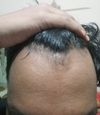community Sulforaphane Topical to Degrade DHT - For People Who Want to Try the Theory that Explains Everything
A user suggests making a potent sulforaphane topical to degrade DHT and promote hair growth. Another user notes that sulforaphane's low molecular weight might also lower systemic DHT.


